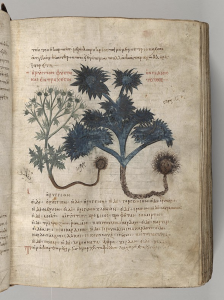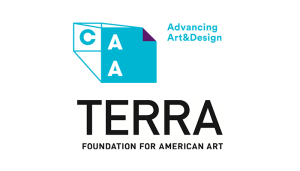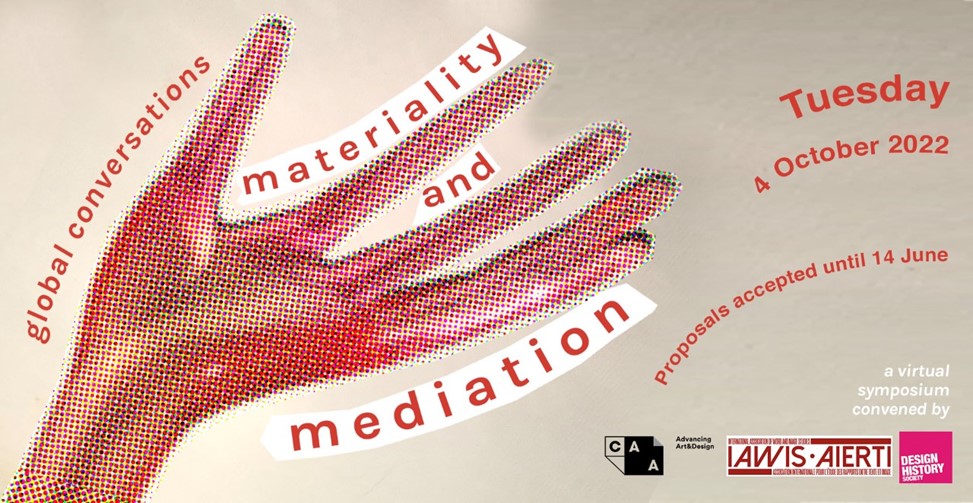CAA News Today
IN MEMORIAM: Samella Lewis
posted by CAA — May 31, 2022
Samella Lewis, an artist, curator, and historian whose writings shaped African American art history, has died at 98. She died on Friday, according to the Museum of African American Art in Los Angeles, which Lewis founded. In 2021, the College Art Association, where Lewis had once been on the publications committee, gave her its esteemed lifetime achievement award.
Learn more about Samella life and work here.
Meet the Spring 2022 Millard Meiss Publication Fund Grant Recipients
posted by CAA — May 25, 2022

Depiction of eryngoes, De materia medica, MS M 652, f. 57r., The Morgan Library & Museum (relates to Griebeler, Botanical Icons: Critical Practices of Illustration in the Premodern Mediterranean)
MEET THE GRANTEES
Twice a year, CAA awards grants through the Millard Meiss Publication Fund to support book-length scholarly manuscripts in the history of art, visual studies, and related subjects that have been accepted by a publisher on their merits, but cannot be published in the most desirable form without a subsidy.
Thanks to the generous bequest of the late Prof. Millard Meiss, CAA began awarding these publishing grants in 1975.
SPRING 2022 GRANTEES
Claudia Calirman, Dissident Bodies: Brazilian Women Artists, (1960s-2020s), Duke University Press
Karen Mary Davalos and Tatiana Reinoza, Self Help Graphics at Fifty: A Cornerstone of Latinx Art and Collaborative Artmaking, University of California Press
Andrew Griebeler, Botanical Icons: Critical Practices of Illustration in the Premodern Mediterranean, University of Chicago Press
Joan Kee, The Geometries of Afro Asia: Art beyond Solidarity, University of California Press
Miriam Kienle, Queer Connections: Ray Johnson’s Correspondence Art Network, University of Minnesota Press
Murad Mumtaz, Faces of God: Images of Muslim Devotion in Indian Painting, Brill
IN MEMORIAM: Christopher M. S. Johns
posted by CAA — May 24, 2022
Christopher M.S. Johns, the Norman L. and Roselea J. Goldberg Professor of Fine Arts and professor of history of art and architecture, died at his home on May 8 after a long illness. He was 67.
Read more about Christopher’s life and work here.
IN MEMORIAM: Wilbur Niewald
posted by CAA — May 11, 2022
Wilbur Niewald, a longtime CAA member and artist, recently passed away at the age of 97. He was professor emeritus at the Kansas City Art Institute and a recipient of CAA’s Distinguished Teaching of Art Award in 1988.
Read more about Wilbur’s life and work here.
In Memoriam: Dr. Margaret Rose Vendryes
posted by CAA — May 11, 2022
Dr. Margaret Rose Vendryes unexpectedly passed away on March 30, 2022. A former member of CAA, Dr. Vendryes was most recently appointed as the incoming Dean of the School of the Museum of Fine Arts at Tufts University. Dr. Vendryes Professor was in the Department of Performing and Fine Arts and Director of the Fine Arts Gallery at York College at the City University of New York (CUNY) and Professor of Art History for more than two decades. Additional information on the life and work of Dr. Vendryes can be found in the announcement Tufts University issues upon her appointment as Dean. That announcement can be found here.
Announcing the Terra Foundation for American Art Research Travel Grant Recipients for 2022
posted by CAA — May 09, 2022

We’re delighted to announce that twenty-four scholars have been awarded Terra Foundation for American Art Research Travel Grants in 2022.
These grants provide support to doctoral, postdoctoral, and senior scholars from both the US and outside the US for research topics dedicated to the art and visual culture of the United States prior to 1980.
The Terra Foundation prioritizes projects that interrogate and broaden definitions of American art and lends support for projects engaged in transforming or complicating how the story of American art is told. To expand histories of American art, we encourage projects that reflect a commitment to inclusive and equitable research and museum practice; generate new scholarship and interpretive frameworks; employ critical methodologies and innovative models; and/or engage diverse partners and audiences.
INTERNATIONAL RESEARCH TRAVEL GRANTS FOR US-BASED SCHOLARS
Doctoral Scholars
Manon Gaudet, Yale University, “Beyond Landscape: Property and the Contested Ground of North American Visual Culture, 1900-1945”
Michaela Haffner, Yale University, “The Visual Culture of Naturopathic Cures & the Fashioning of White Wellness”
Annie Ochmanek, Columbia University, “Conceptualism and the Connexionist World: The Art of Eduardo Costa, Hannah Weiner, Christine Kozlov, and Stanley Brouwn”
Constanza Robles, Boston University, “Visualizing Alliances through Art and Architecture: Pan Americanism, Hispanismo and Latin Americanism in World Fairs, 1901-1929”
Lea Stephenson, University of Delaware, “’Wonderful Things’: Egyptomania, Empire, and the Senses, 1870-1922”
Postdoctoral & Senior Scholars
Maria Elena Buszek, University of Colorado, Denver, “Art of Noise: Feminist Art and Popular Music
John J. Curley, Wake Forest University, “Critical Distance: Black American Artists in Europe 1957-1968”
Emily Voelker & Erin Hyde Nolan, UNC Greensboro and Maine College of Art, “Reading Native American Portraits in Ottoman: Global Economies of Nineteenth-century Survey Photograph”
INTERNATIONAL RESEARCH TRAVEL GRANTS TO THE UNITED STATES
Doctoral Scholars
Marion Belouard, University of Limoges, “Painting nature, exchanging knowledge. John James Audubon (1785-1851), a rare bird in Atlantic history?”
Cora Chalaby, University College London, “Control Systems: Helen Frankenthaler, Joan Mitchell, Alma Thomas, and Howardena Pindell’s Orderly Abstractions”
Clara Johanna Lauffer, Central Institute for Art History, Munich, “Rewriting the ‘pictures generation’: the production of white masculinity in appropriation art”
Mylène Palluel, Université Paris 1 Panthéon-Sorbonne, “The ‘Longue durée’ paradigm in 1960s American art and social sciences. Case studies in Minimal Art, Conceptual Art and Land Art”
Mona Schubert, University of Cologne, “Photographic Media at documenta in the 1970s and the US-American Art Scene”
Clara Royer, Université Paris 1 Panthéon-Sorbonne, “Slow-Scan: the (geo)political turn of media arts (1960-1990)”
Yana Shtilman, Université de Paris, “Public image, private lives: Creating the image of the “New Negro” woman in the Harlem Renaissance (1920-1943)”
Achang Su, China Academy of Art, “The Identity Issues and Abstract Transformation in the works of Modern Chinese-American Artist George Chann from 1950s to 1960s”
Postdoctoral & Senior Scholars
Alice Butler, Courtauld Institute of Art, “The Perversions of Textile in Feminist Art”
Anne-Claire Faucquez, Université Paris 8, “The narrativization of colonial slavery in American museums: arts and representations” (collaborating with Androula Michael)
Roula Matar, École nationale supérieure d’architecture de Versailles, “James Johnson Sweeney’s Contribution to a Critical and Didactical Approach to Exhibition Installation”
Androula Michael, Université de Picardie Jules Verne – UFR des arts, “The narrativization of colonial slavery in American museums: arts and representations” (collaborating with Anne-Claire Faucquez)
Yvonne Schweizer, Eberhard Karls Universität Tübingen, “Linking Mediatization and Mediation. Art Institutions as Media Producers since 1970”
Harry Weeks, Newcastle University, “The Artist’s Second Shift”
Andrew Witt, Humboldt-Universität zu Berlin, “Exile Modernism: Photography c. 1940”
LEARN MORE ABOUT THE TERRA FOUNDATION RESEARCH TRAVEL GRANTS
CAA signs on to letter to EPA protesting closure of online archive
posted by CAA — May 05, 2022
The College Art Association has signed onto a letter from the American Society for Environmental History directed to the EPA in protest of the agency’s decision to retire its online archive. The text of the full letter is provided below.
—
The Honorable Michael Regan
Administrator
Environmental Protection Agency
1200 Pennsylvania Ave. NW
Washington, DC 20460
michael.regan@epa.gov
Re:
Dear Administrator Regan,
We the undersigned write to express our opposition to EPA’s plan announced in February to sunset its online archive in July 2022. The vast majority of our government’s interaction with the public comes through digital channels; public digital archives such as the EPA’s are of enormous value to historians as well as to the public.
This EPA archive has already proven immensely useful to environmental historians. Not only are citations to it regularly featured in traditional scholarly venues, it has greatly facilitated projects such as “A People’s EPA”, a website and Twitter feed through which historians help explain the work of the EPA to a broader public.
Not just historians but those from a variety of academic disciplines as well as the public rely on the EPA digital archive for information, insight, and analysis. The site has provided resources for others working in ecology, biology, toxicology, and other environmental sciences as well as geography, law, sociology, political science, and public health. Professors and teachers at various levels, from K-12 schools to the graduate level utilize the archive as a pedagogical resource, directing students to pages that offer authoritative records of the geographies they are exploring. Not least among those who have relied on the EPA’s online archive are those working with and living in more marginalized or environmental justice communities, a stated priority of current EPA leadership.
Having easily accessible documentation of the extensive EPA’s investigations and records of decision for Camp Lejeune, North Carolina, for instance, has helped overcome local doubts about the agency’s effectiveness, yielded greater understanding of chemical exposures, and otherwise significantly supported the agency’s efforts at clean-up. Here and elsewhere, residents faced with a potential environmental hazard can more easily access the agency’s past work in their locale as an aid to understanding prior investigations at the site.
The importance of EPA’s online archive is perhaps best illuminated by considering what will be lost when this archive is taken down. The many mentioned uses of EPA documents will become much more difficult for those who cannot travel to EPA’s print collections, and with any pandemic recurrence, well-nigh impossible. A tremendous gap will also open up in what more recent historical records are accessible, as it takes many years for any preserved documents to be transferred to and made available through the National Archives. It will become much more difficult for historians to assess and interpret this agency’s recent past, much less to situate it within longer histories and larger contexts.
We understand that the EPA’s provision of a public archive of its own documents and deliberations is voluntary and that online maintenance entails some costs. But those need to be factored against the better and broader understanding it has nourished of the vital work done by this federal agency, whose own future hinges on greater public awareness of and support for what it does. Instead of doing away with the EPA archive, the Biden administration should promote it as a model for other parts of the Executive Branch. In our digital age, agencies should make their own publications and other public interactions more quickly, thoroughly, and durably accessible, both to historians and to the larger publics our government serves.
Call for Proposals: Materiality and Mediation: Global Conversations
posted by CAA — May 02, 2022

Materiality and Mediation: Global Conversations
Tuesday, 4th October 2022.
A virtual symposium convened by the CAA, the Design History Society, and the International Association of Word and Image Studies
To what extent are materiality and mediation useful foci in the study of design, word and image? What happens when we bring them together? How do materiality and mediation work in tandem as productive subjects of enquiry? What are the local, regional and international variations in the ways these foci are understood and engaged by design historians and those working in word and image studies?
This global collaborative project brings together three intersecting constituencies—art and design, design history, word and image studies—to examine the ways in which materiality and mediation intersect.
- mediating the ethics and sustainability of extraction and deployment of materials
- sensoriality of materials and mediation
- mediation as material activism
- mediating intersections of materiality and form (natural/synthetic/digital matter; art/craft/design/film/photography; prose/poetry/drama)
- localizing/globalizing materials through mediation
- ‘raw and cooked’ materials
- mediating materialities of scale
- mediating immateriality
- mediating materials as signifiers of identity politics
- (Im)material media of mediation
- agency of materials
- dialogues and disputes between makers and mediators.
- a proposal title;
- an abstract of 250 words;
- a statement of relevance to the symposium theme, Materiality and Mediation: Global Conversations;
- and a one-page CV listing major publications.
Please send your proposal via email to the DHS Administrator, Jenna Allsopp, (designhistorysociety@gmail.com) by 12 midnight GMT on Tuesday June 14, 2022. Notifications of acceptance will be emailed on July 8, 2022.
The Design History Society and the International Association of Word and Image Studies are two of CAA’s affiliated societies. If you have an interest in joining CAA as an affiliated society, please visit this page.



